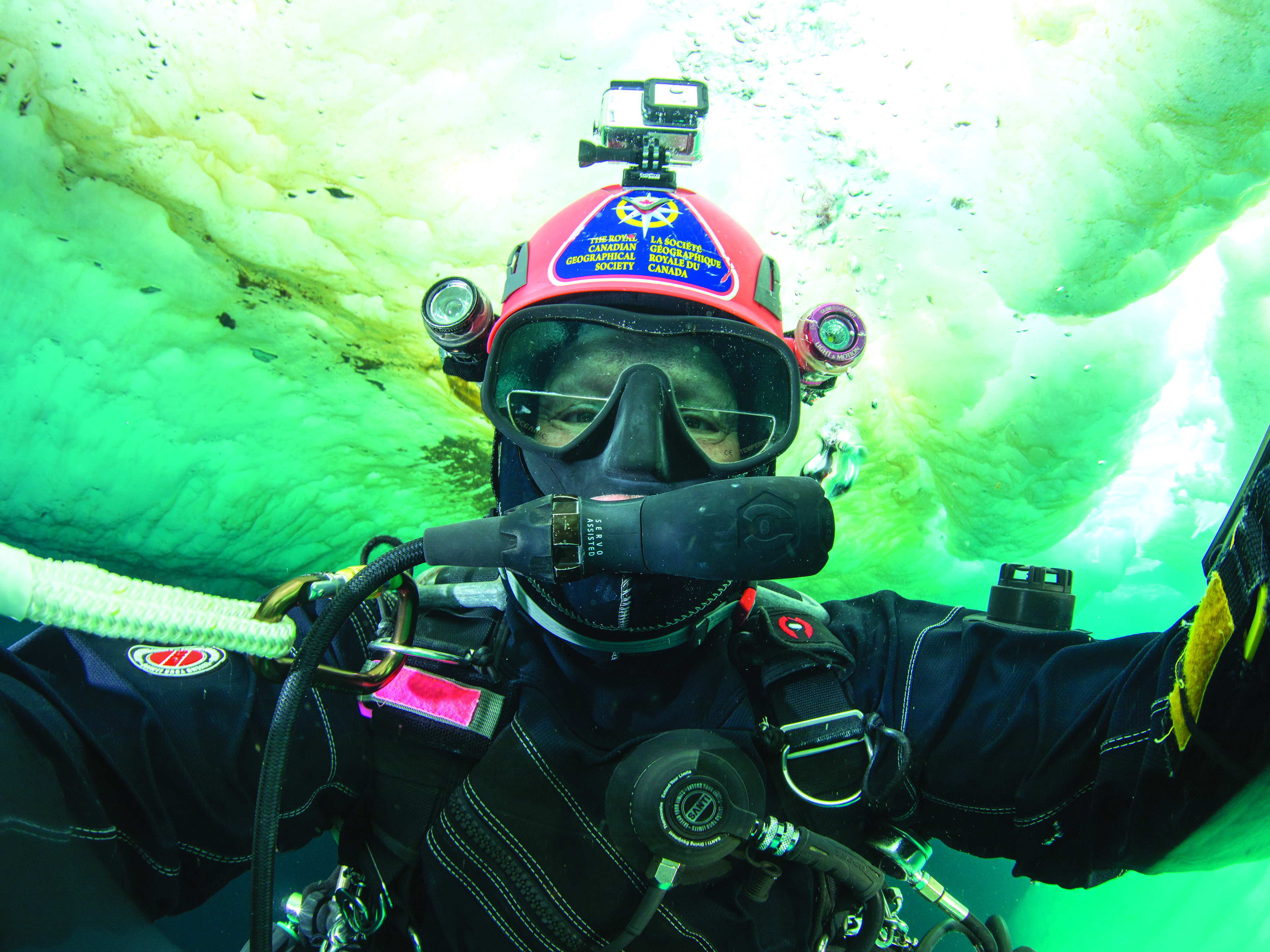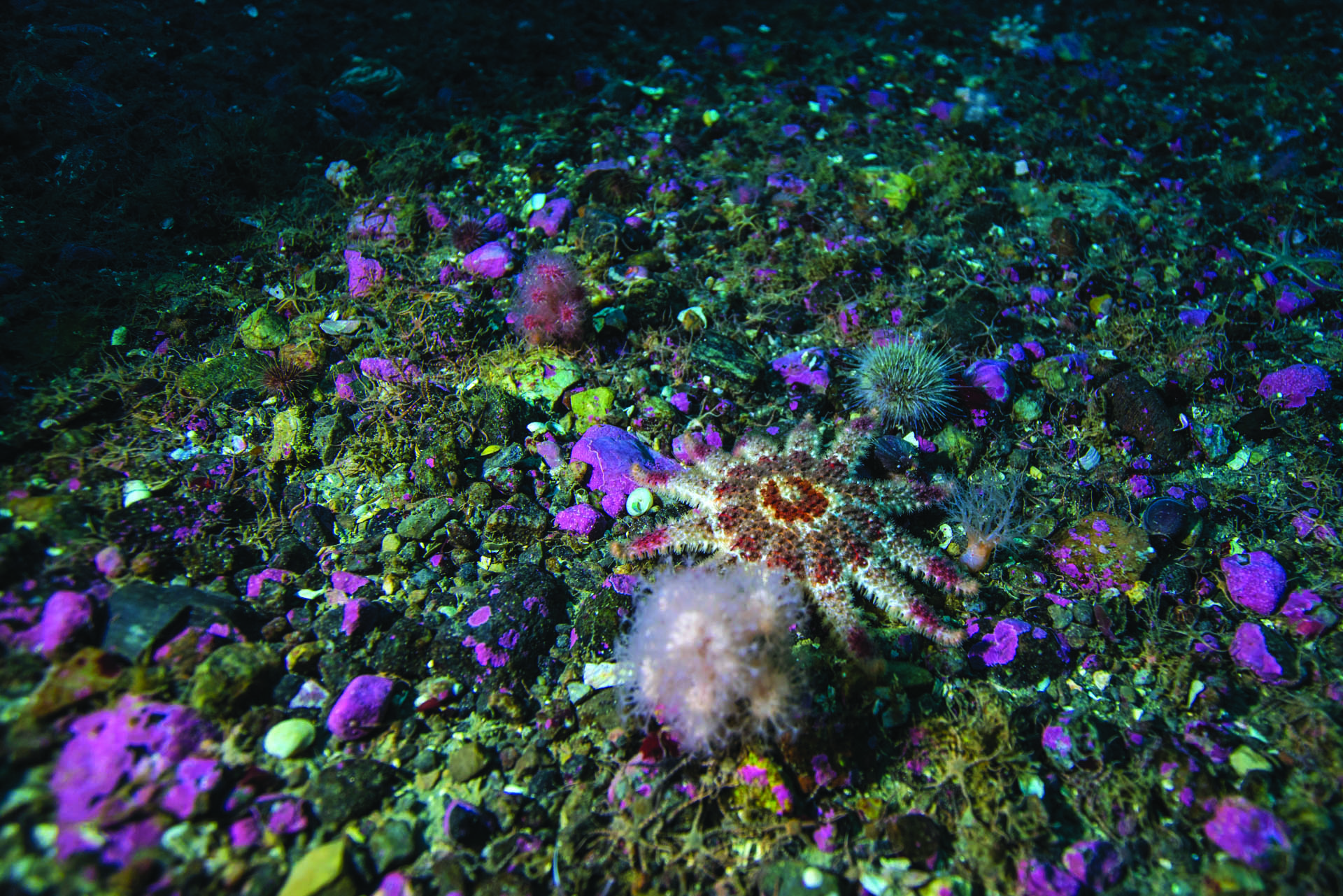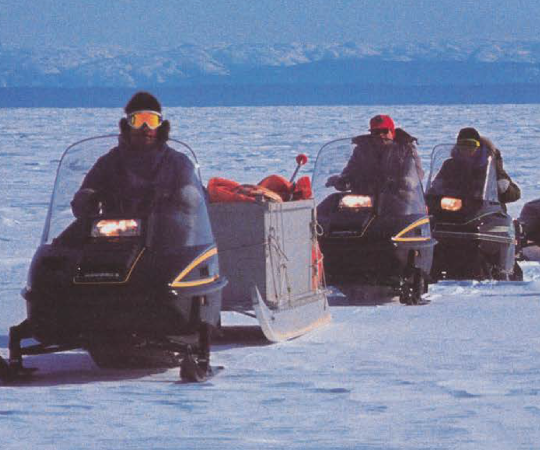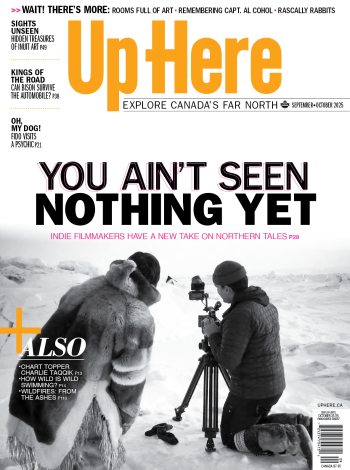Jill Heinerth pulls on a neoprene balaclava and adjusts her thick rubber gloves. Wearing a puffy drysuit, red helmet, and 30-pound oxygen tank on her back, the underwater explorer stands at the floe edge in Lancaster Sound, the eastern entrance of the Northwest Passage. She’s joined by colleague Mario Cyr, local guide David Oyukuluk, another Inuit guide from Arctic Bay, and a six-person camera crew. It’s June 2018, and Heinerth and Cyr are going to dive beneath the sea ice and film what they see.
“The floe edge is almost like a moving buffet,” Heinerth tells me when we chat on the phone this past April. “Every day, it sort of breaks away, and as it does, it’s releasing ice and nutrients back into the ocean. Everything in the summer comes to feed [there], from polar bears and narwhals to belugas and eider ducks.”
In other words, it’s the perfect spot to dive—though getting there had not been easy. During spring, the floe edge can move miles per day as it breaks up. The team, on skidoos hauling qamutiit packed with scuba gear, slogged through slushy top water and around growing leads (long cracks in the ice) until they found it, some 80 kilometres from shore outside Arctic Bay.
Heinerth and Cyr do one last check of their gear. They are each attached to a rope held at the other end by a guide. The rope helps the diver find their way back out through the ice. It also warns them of a polar bear nearby, through the tug from a guide. Tightening flippers on their feet and popping regulators in their mouths, the pair waddle to the edge, jump into the frigid water, and slowly sink beneath the surface.
The transition between worlds is sharp on the senses, and Heinerth and Cyr move slowly and cautiously. The sub-zero water is cold on the parts of the faces their diving hoods don’t cover, but they barely notice, swept away instead in their surroundings.
Strands of green and brown algae, which feed small shrimp and zooplankton, hang from the craggily sea ice above. Luminescent jellyfish drift through the water and a school of Arctic cod darts by. Below, the divers can just make out the white of a beluga pod passing through the darkness, watching the humans with playful curiosity.
It’s remarkable to see this life up close. But of all sensations accompanying the dive, Heinerth is most struck by the sound. Thinking back on it as we chat, she struggles to adequately describe it.
“It literally sounds like, I don’t know, some alien world,” Heinerth says. “I mean, the ice is cracking and popping. It’s also fizzing as it’s releasing gas while it’s melting.
“But it’s the animals that are incredible. I can hear bearded seals and ringed seals. They make this trill sound that goes several octaves. Then narwhals click their teeth, and belugas sing like canaries. All of these animals will be speaking at once, communicating with each other.
“It’s so loud,” she says. “Almost deafening.”
With footage from this floe edge adventure, along with expeditions to Greenland and Hudson Bay, Heinerth and Cyr produced a short documentary titled Under Thin Ice. It premiered in 2019 on CBC, offering audiences around the country an intimate portrait of the High Arctic and a chance to witness, on the screen, scenes like the one above.
Watching Heinerth’s freezing forays on television would be enough for most viewers. But to diving enthusiasts, the allure of the Arctic is too strong to resist.

The Arctic Ocean—vast, remote, and tucked away under ice for most of the year—is something of a Holy Grail for underwater adventurers. The warmer seasons tend to lure a small but enthusiastic selection northward.
Montréaler Nathalie Lasselin has been leading diving expeditions out of Pond Inlet, on Baffin Island, with Arctic Kingdom (currently the only operator offering regular trips in the area) for more than a decade. Throughout the years, she has been a guide for hundreds of tourists from around the world, including the U.S., Mexico, Australia and Europe.
An experienced diver herself, Lasselin understands the draw. She’s explored underwater caves in rural southwestern China and Mexico’s Yucatan Peninsula, discovered old shipwrecks around Newfoundland’s Bell Island, and swum 70 kilometres along the bottom of the St. Lawrence River. Of all these places, she’s found the Arctic always offers the most excitement.
“What I really, really love about that environment is the fact that you cannot put a point on the map and say, ‘Well, this is a dive site,’ because it’s always changing,” she says. “The ice might be there today, but not tomorrow.
“Am I going to dive on an iceberg? On the floe edge? Near the shore? I don’t have a clue, and I can’t predict that.”
Arctic dives aren’t cheap. Arctic Kingdom’s typical eight-day itinerary involves traveling from Pond Inlet by snowmobile to a camp on the sea ice of Eclipse Sound. From there, staff and guests venture out each day to check out potential dive sites. The average total cost? About $22,160 per person.
What’s more, the harshness of the environment only adds to what is already a pretty dangerous sport. Those who come should not only be certified (obviously), but comfortable with cold water and using a dry suit.
There are a lot of safety measures to take into consideration. Keeping a backup bottle of oxygen on hand is always a good idea in case the cold water freezes the regulator in an open position and causes a free-flow of air. When diving under ice, being tethered to a rope not only provides a sense of direction, but stops a strong current from carrying someone several kilometres away from the opening. Never going deeper than 100 feet lowers the chances of decompression problems (like when nitrogen bubbles form in your bloodstream, also known as “the bends”). And having a means of warming up after you surface staves
off frostbite.
Most importantly, hiring expert Inuit guides is an absolute necessity. The weather, ice and wildlife can be dangerous for those who are unfamiliar. With their local knowledge, the guides can inform the group where it is or isn’t safe to go, while keeping watch for prowling polar bears. “It’s their territory and it’s their land,” Lasselin says, “so it’s really important for us to work with them, because it’s their home.”
But if divers are cautious and patient, they are rewarded with the opportunity to explore a place unrivaled in its majesty. “It’s about experiencing a pure environment,” Lasselin says. “It’s a place that we can’t conquer, and you are just a tiny little thing in the middle of it.”
This notion resonates strongly with Françoise Gervais, another diving guide. She remembers how overwhelmed she felt when she saw the Arctic Ocean for the first time.
“You have a 360-degree view that’s just endless, and you realize you’re in a landscape where you can look around and don’t see any humans. There’s no bridges, no trails, no roads. It’s a certain freedom.”
Gervais first ventured into the polar region in July 2014 after being asked to join a team of 10 women—Heinerth among them—who would travel up the Labrador coast to Baffin Island then across the Davis Strait to western Greenland, stopping to snorkel and explore along the way. Organized by environmental non-profit Sedna Epic Expedition, the group sought to highlight the disappearance of sea ice and impacts of global warming through photography, videos and connecting with local Inuit communities to hear stories about its human toll.
“It was really diverse,” Gervais says. “There were scientists, a pilot, a banker, someone from the Vancouver Aquarium. A lot of very like-minded people who wanted to bring some attention to what was happening up there with climate change.”
Not too far into the trip, Gervais realized she was hooked on the landscape. When a job opened up on the boat the group had chartered, she was quick to snap it up and stay on board in the North for the rest of the summer. It gave her important connections and experience. Within a year, she was guiding expeditions for Arctic Kingdom herself.
Now, Gervais has upwards of 30 Arctic dives under her belt and a long list of stories to go along with them. There was the time she swam alongside narwhals as they dove under the ice, or the day when she and her diving buddy checked out a tunnel through a grounded iceberg.
That last one is probably Gervais’ favorite experience. Covered in ridges and rivulets carved by waves, these massive hunks of ice can stretch as far down as 500 feet to the seafloor like a “cathedral under the water,” Gervais says.
“The feeling you get around icebergs is like when you’re a kid and you are in a tall building, and you kind of run at the window and get a little vertigo,” she says.
“It’s fun to be so vulnerable.”

It's not jut recreational divers who come North seeking adventure. As far as science is concerned, it can be the research opportunity of a lifetime.
Best current estimates suggest 80 percent of the world’s oceans remain unmapped, unexplored, and unobserved, while 90 percent of marine species have yet to be classified. Nowhere is this statement truer than in the Arctic Ocean, a place that has been critically under-explored and understudied.
“There hasn’t been a lot of scuba diving research in the Arctic at all, and there’s not a good baseline of what’s normal,” says marine ecologist Jessica Schultz.
“What kind of life do you normally see? And where is it? How abundant is it? That’s quite critical as we look to understand how climate change is affecting [marine life] and the communities that rely on it.”
One group working to collect data and establish that baseline is the B.C.-based conservation organization Ocean Wise, which started sending small dive crews North for the summer in 2015. Working primarily out of Cambridge Bay when the sea ice was gone, crews would do two to five dives a day from the shore or off the back of a boat in open water—a feat far less technically challenging than diving at the floe edge, since you don’t have to worry about getting lost under ice.
Still, this work required careful attention to detail. Divers swam along the seafloor and took copious notes, pictures, and videos of all the species they saw, from jellyfish, to sea anemones, to cold-water corals. At times, they used a tool called a transect (which almost resembles a measuring tape), laying it out on the seafloor and counting how many of one species they observed within two metres on either side.
Schultz was a dive team member for Ocean Wise in 2018 and 2019. To this day, she can’t get over how, 500 kilometres north of the Arctic Circle, the summer waters around Cambridge Bay were as clear and bright blue as the tropics. She was particularly fond of diving around Finlayson Islands, several hours by boat off the coast of the community. The rocky seafloor was a colourful explosion of life.
“It’s an absolutely special place,” Schultz says. “I just fell in love with the beauty and the diving up there, and I’d love to go back.”
Meanwhile, marine scientist Laura Borden has been to the Arctic every summer since 2016—first with Ocean Wise to Cambridge Bay, then as a consultant for other organizations and companies. She’s done dives near Grise Fiord, Devon Island, and all along Lancaster Sound.
She compares the species she sees in the Arctic to those along the Pacific coast of her native British Columbia, where she has completed some 650 dives in her life. Surprisingly, those species are often a lot larger in the North.
“There’s little animals called sea angels,” Borden says, offering an example. “In B.C., I’ve only seen them a few times and they may be an inch or so tall. But up in the Arctic, you would see ones that were up to four inches in size. By their standards, that’s enormous.”
For a scientist like Borden, these experiences are about as wonderful and awe-inspiring as it gets. Yet just as incredible, she says, was the time spent in communities. There’s an important exchange of knowledge: community members help researchers navigate the environment, and researchers can reciprocate by sharing what they find.
Borden thinks back to one particular summer in Cambridge Bay, when the dive team collected various samples of species living along the seafloor. This helps scientists get a better picture not only of those creatures themselves, but the role they play in the vitality of the entire ecosystem—and how it affects the animals important to local diets. Afterwards, they invited local residents to an open house to see what they had found and ask questions.
“That was really cool, because a lot of the time, the communities don’t necessarily know everything in their marine environment, especially when it comes to invertebrates and things like that,” Borden says. “And their amazement and interest in that, I think, makes the work that I’ve done even more valuable.”
As one can imagine, there are many challenges to conducting consistent, long-term underwater research in the Arctic. The high costs and complicated logistics remain a barrier for many organizations. Ocean Wise hasn’t been able to send a crew north since the onset of the COVID-19 pandemic.
Nonetheless, diving research in the North is slowly but surely growing. In 2019, the Canadian High Arctic Research Station (CHARS) opened its doors in Cambridge Bay, fully equipped to help diving scientists from around the world fill oxygen tanks and boat out to survey locations. A permanent four-person diving team has also been recently added to the station’s roster of research supports. This summer, their first project will be assisting with specimen collection for research led by the Canadian Museum of Nature on Arctic kelp forests and their role within the marine ecosystem.
“The excitement level is quite high when you think you can be part of identifying new species, or seeing things that nobody else has actually ever seen,” says Scott Johnson, manager of field operations for CHARS and a member of the dive team. “It’s a very exciting thing for the dive team members, but also for the researchers as well—that there’s something out there still to discover.”
Now working on her PhD in marine biology at the University of Guelph, Schultz says she’s optimistic about how a facility like CHARS can help research in the area grow—but she wants to see the work being done translated into real-life solutions for communities.
“All that baseline work is critical, but it’s also kind of a low-hanging fruit,” Schultz says. “I think the harder question to ask is, ‘Now what?’”

By now, it's no secret that the Arctic, warming three times faster than the rest of the world, is ground zero for climate change.
Massive sea ice losses are a well-documented phenomenon. NASA estimates average ice coverage declined by 13 percent per decade between 1981 and 2010. A 2021 report from the United Nations’ Intergovernmental Panel on Climate Change predicted the Arctic Ocean would be “practically ice-free” at its summer minimum at least once by 2050.
Already, the animals and people living in the Arctic are having to adapt. So much of Inuit life relies on healthy and predictable sea ice—for transportation, hunting, and recreation. The entire marine ecosystem hinges on the nutrients this ice provides.
That’s why Heinerth—with Canada’s Polar Medal, induction into the International Scuba Diving Hall of Fame, and the bestselling memoir Into the Planet—has made it her life’s mission to share her experiences with others. If people learn about the Arctic Ocean and its biodiversity for themselves—even if just on a screen or in the pages of a book—they’ll better understand what’s at stake. And that might just inspire them to take action in their own lives.
Heinerth says diving isn’t just about the thrill. “It’s about gathering images, or scientific data, or cultural stories that we can share.
“It’s about sharing that beauty and the joy, and encouraging other people to love and protect these things that I’m so fortunate to see.”









